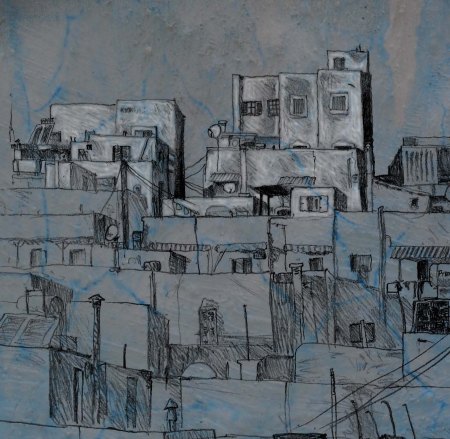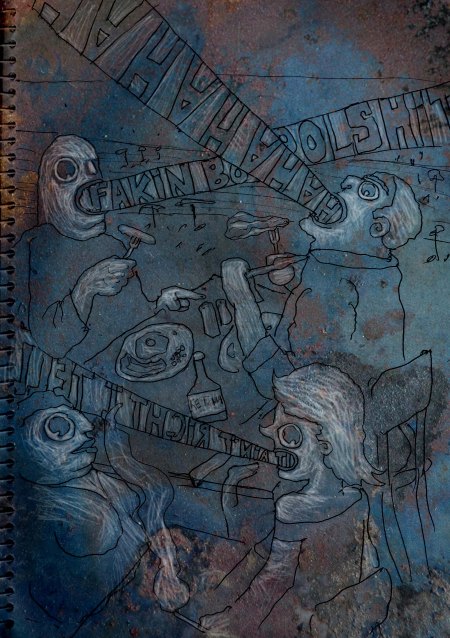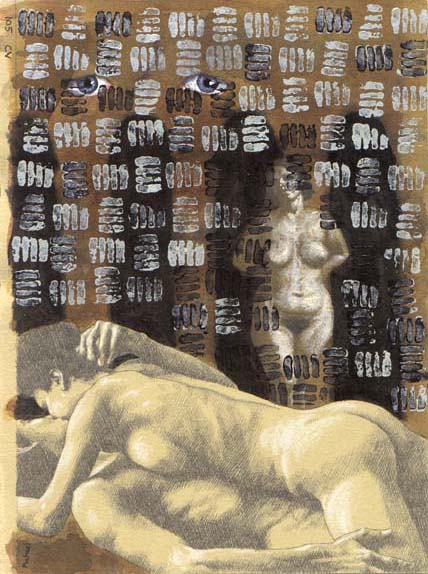You might be thinking that I’m showing favoritism by once again announcing a release by UK artist Dave Migman. It’s certainly true that I like his work and would love to enlarge his audience. It’s also true that he’s relatively prolific. While most of us seem to be running our children around town or getting sucked into another season of some television show or other (now that we can stream whole seasons over a weekend, why bother with anything else?) he’s busy making stuff. Not that artists don’t deserve a little relaxation and a chance to fill themself with the mental equivalent of a Twinkie but, really, we’re usually happier making stuff.

A drawing from Learning How to Live and Die. Copyright Dave Migman.
Migman’s most recent release on Bandcamp, Learning How to Live and Die, has many of his delightful drawings. His writing, as always, is visceral, blood and sinews, corporeal, tangible, and in-your-face outraged. That is, he’ll probably offend your finer sensibilities and get himself thrown out of any polite discussion of office politics. The sounds here, behind the words, are spartan, especially compared to his last release iPadded Cell, and, as always, help build a sense of immediacy and intensity.

Another drawing from Learning How to Live and Die. Copyright Dave Migman.
According to the notes on Bandcamp’s page, these works were originally “dogcasts” written and performed in 2012 for Doghorn publishing. Then, “This version has been re-edited, scooped and hollowed and then pumped with reinforced concrete. Some readings are recent, others old. It recounts a journey through Greece back in 2007 and much was written under the influence of Grecian Village white wine, while staring at the gathering dusk.”

A third drawing from Learning to Live and Die. Copyright Dave Migman.
I hope you have the time and money to venture over to Bandcamp to buy all his recordings. (I think all his downloads are name-your-price.)
Also available at Bandcamp is my own collection, 20 Years Frozen for
All Time, with selections spanning 1996-2016. Compared to my previous retrospective collection, 15 Years of Prattle and Din, this one better represents my earlier, pre-computer years of recording. It is a 2-disc collection (though it downloads as a single stream of twenty-one compositions) lasting over 2 1/2 hours. It’s hard to do anything else while listening to any kind of spoken word, so this could be quite a chore to listen to. The collection includes a 72-page booklet, both in standard PDF and in a printable version (set out in 12-page signatures that need to be collated, trimmed, and bound), and binding instructions. The content of several recordings and certainly that of the booklet are sexually explicit and not appropriate for all ages or philosophical states of mind. The booklet is thick with biographical detail, forays into my recording history (which you can find in even greater detail on my blog Prattle and Din), essays on the creative process, the texts for all included recordings, as well as some notes specific to each recording (again, you can find much more on the blog).

Drawing 105 from Laughing Water. 6″x 8″ graphite and acrylic on Rieves BFK. Early to mid-1990s. One of the more socially acceptable (that is, less explicit and therefore less “offensive”) drawings from the series. Copyright Michael Myshack.

Drawing 107 from Laughing Water. 6″x8″ graphite and acrylic on Rieves BFK. Circa early to mid-1990s. Another “tame” image from the booklet. Copyright Michael Myshack.
